Primary navigation
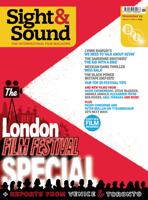
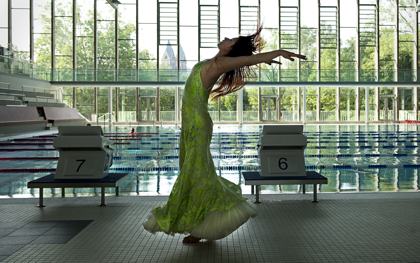
Two years on from Avatar, audience fatigue and critical scepticism may be peaking just as genuinely adventurous 3D work is coming our way. Don’t write off the format yet, says Ian Christie, as he examines 3D from a historical perspective
“Will the cinema of the future be stereoscopic? Will tomorrow follow today?”
Guess who wrote that, and when? James Cameron? Jeffrey Katzenberg, taking DreamWorks into full 3D? Any CEO of a cinema chain that’s been benefiting from the premium box-office delivered by 3D films since Avatar launched in December 2009? Nope, it was Sergei Eisenstein, writing shortly before his early death in 1948.
For many who believe that the current hyper-promotion of 3D is little more than a cynical ploy to regain the youth audience for cinema with a new gimmick, or to promote a piracy-proof format, Eisenstein’s enthusiasm may come as a surprise. What gave him such confidence in this new technology, only four years after he had managed to make a film in colour for the first time? Ostensibly, it was the premiere of Robinson Crusoe, the first glasses-free stereoscopic dramatic feature in colour by Russian pioneer Semyon Ivanov, which took place in Moscow in February 1947. But Eisenstein had less to say about Ivanov’s film than he did about stereoscopic film as the culmination of all that cinema – and the history of theatre – have been aiming for over millennia.
Breaking down the barrier between audience and performance, according to Eisenstein, has been the main goal of all great forms of theatre, from the amphitheatres of Ancient Greece to the baroque theatre of the court masques and the Japanese kabuki, right up to the revolutionary Soviet theatre that he’d been a part of in his youth. But his argument wasn’t only based on theatre; a rapid survey of trends in 1940s cinema, including such films as Hitchcock’s Spellbound (1945) and Powell and Pressburger’s A Matter of Life and Death (1946), pointed to filmmakers aiming to implicate the spectator by composition in depth and a battery of point-of-view devices.
Stereo cinema, surely, is what they’re all reaching out for? Only Western reactionaries, Eisenstein claimed, would want to argue against it – reminding us that his article was written during the first spike of what would soon become the ideological Cold War, and before the first wave of 3D films in the early 1950s that culminated in Hitchcock’s Dial M for Murder (1954).
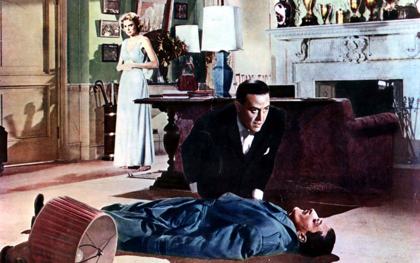
Dial M for Murder
But if we leave aside the Soviet triumphalism, it’s easy to map on to Eisenstein’s early defence of 3D the tide of critical scepticism and outright hostility to the format that we’ve seen over the last two years. Probably the most influential voices in this have been the editor Walter Murch and the critic Roger Ebert, whose January 2011 blog post ‘Why 3D Doesn’t Work and Never Will’ has become a frequent reference-point for opponents.
It wasn’t Avatar that roused Ebert’s ire, but one of the host of ‘faked’ 3D films that followed in its wake – Michel Gondry’s The Green Hornet. ‘Faked’ refers to the process of creating a 3D effect in post-production with material that has been shot in normal 2D – a process undertaken with gusto by many major Hollywood studios once the bonanza of higher ticket prices and overall revenues from 3D was spotted.
For Avatar, James Cameron had unquestionably conceived a mise en scène that plays on the revelation of a ‘new world’ – the planet of Pandora – that his protagonist enters through a form of virtual reality. And this functions for the audience as, literally, an entry into the perceptual possibilities offered by Cameron’s use of advanced stereoscopic compositing. Self-referentially, it becomes an allegory of liberation for the paraplegic ex-marine Jake (Sam Worthington) as he enters his Na’vi avatar, and for us as we enter the new world of RealD – whether or not we buy the film’s larger identification with the fight against a rapacious invading imperialism.
Notoriously, many critics did not buy it, proving themselves significantly out of step with much audience reaction, although it should be said – in view of his role in challenging 3D – that Ebert was not one of these. His review was one of the most enthusiastic by an established and influential critic, hailing the film as “sensational entertainment” and a “technical breakthrough” with a “flat-out Green and anti-war message”. He also praised Cameron’s restrained deployment of 3D, never used to “promiscuously violate the fourth wall”.
Avatar
Interestingly, a new in-depth report for the BFI on what the British public feels about film, ‘Opening Our Eyes’, echoes Ebert’s response. Asked to nominate one film that was significant for them, 42 respondents from the sample of over 2,000 chose Avatar, released over a year earlier. (The most frequent choice, with 100 mentions, was The King’s Speech – at the height of its fame when the survey took place in late February 2011 – followed by Schindler’s List, with 75.)
What’s particularly interesting about the survey respondents who chose Avatar is their wide age range, with people in their forties and fifties commenting on the film taking “animation to a whole new level” and 3D intensifying emotional engagement. A recent experiment carried out in Bristol that compared the relative level of ‘presence’ experienced by viewers of the film in 3D and in 2D reported, perhaps unsurprisingly, that 3D mostly delivered greater immersion. The point is that Avatar doesn’t depend entirely on its 3D artifice for its sensory – and indeed aesthetic – impact, but that these are considerably enhanced by Cameron’s wholehearted commitment to – and invention of – a stereoscopic world.
Sadly, and I think damagingly, many of the 3D films that have followed Avatar were not conceived by true believers. Indeed there are reports of sceptical, and certainly unprepared, filmmakers whose efforts were enhanced by the new breed of on-set stereographers, or merely tweaked in post-production to create the commercial proposition of X, Y and Z ‘in 3D’, while this was proving such a sensational box-office draw during 2010 and early 2011. The box-office results from Burton’s thinly imagined Alice in Wonderland and even the execrable Clash of the Titans – a true example of ‘applied’ 3D – may have been impressive, but these can have done little to convince the doubting that 3D had a real future as a new filmic language. By contract, more modest UK ‘native 3D’ productions, such as StreetDance and the motorcycle race documentary TT3D, were more promising in this respect.
But the cost of planning and shooting in native 3D remains considerable. An even greater obstacle may be the lack of enthusiasm among established filmmakers. I was surprised when interviewing the Russian director Andrei Konchalovsky – who has made a major feature in 3D, The Nutcracker – that he vowed never to work in the format again, citing Ebert’s verdict, and the supposedly validating argument by Walter Murch that Ebert has put into circulation.
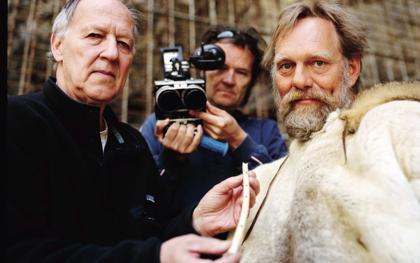
Cave of Forgotten Dreams
Murch is the highly respected sound and picture editor, best known for his work with Francis Ford Coppola on The Conversation and Apocalypse Now, but also considered by many a sage theorist of the medium. In a letter quoted by Ebert, Murch argued that even if the widely admitted problem of 3D projection making the image seem dim could be solved, there remains something more fundamentally wrong with the 3D illusion. Since it requires our eyes to converge and focus at different points, we have to “work at” sustaining the illusion. This means, Murch argued, that “the ‘CPU’ [central processing unit] of our perceptual brain has to work extra hard”, resulting in the headaches that some viewers report. And for Murch it’s a “deep problem” that “600 million years of evolution never prepared [us] for”.
Such technical talk about the mechanics of perception has undoubtedly impressed many. But the evolutionary biology that Murch invokes cannot be used to prove our inability to adapt to new perceptual demands. Binocular vision, as distinct from the independent, sideways-facing eyes of other animal groups, may well have developed in primates to aid their search for prey. Since that distant era, human binocular vision has adapted to vastly different conditions, including modern, increasingly screen-based life. And it is considerably more complex at a neural level than Murch implies.
This is not to deny that a number of viewers of 3D films report headaches, and a significant minority do indeed lack the ability to ‘see’ this illusion, in the same way that between 7 and 10 per cent of the total population have the deficit popularly known as ‘colour blindness’. But Murch is claiming that 3D is physiologically ‘against nature’, which I suspect is highly dubious on scientific grounds. The more we know about the intricate neural processing that supports our vision, the more we realise that it’s highly adaptable to new challenges and goals. Like those who once doubted, sincerely, that man was meant to travel as fast as the early railways could carry him, claims that 3D isn’t natural may come to look rather quaint.
However, what’s undoubtedly true is that poorly conceived and presented 3D can cause what vision researchers distinguish as ‘visual discomfort’ and ‘fatigue’, the one a subjective (although genuine) reaction, the other a measurable impact that has implications for those who use stereo visualisation in technical fields. These are due to the basic illusory mechanism that permits stereo displays, which is an uncoupling of the eyes’ normal ‘vergence’ (or rotation) to deal with objects near and far, and the matching ‘accommodation’ reflex – factors that were investigated as long ago as the 1890s by one of the pioneers of vision research, A.S. Percival. In fact the amount of dissociation the eyes can tolerate is still known as Percival’s ‘zone of comfort’, and this is what 3D has to work around.

Pina
Murch is right to say that the discomfort reported by some viewers would disappear if we had holographic displays, which must be the ultimate goal for 3D. Certainly no one enjoys having to wear the current generation of glasses. But on the scientific front, there is a considerable body of research – much of it driven by the development of 3D television systems – that shows convincingly that well-managed stereo doesn’t cause fatigue or eye strain, except for a minority of viewers who may never enjoy the effect (rather like those, including me, who know that whirling fairground rides are not for them).
But would we want everything in 3D, as Katzenberg has pledged for DreamWorks output? Does it have to be all or nothing, as some are urging – on both sides? Or can it become a significant and permanent part of our audiovisual culture? Here’s where a historical perspective may be useful. What cinema has taken on board during the last hundred years has not represented a single line of ‘progress’, from flickering ‘animated photographs’ to the latest in seamless CGI. Rather, it has been a slow process of realising what the pioneers already envisaged, with much resistance from purists along the way.
The invention of sound recording preceded moving pictures by at least 15 years, and the Stereoscope was even earlier, offering an enhanced 3D vision of the world to millions of Victorians in what was the first great ‘optical entertainment’ craze of the mid-19th century. Louis Lumière, creator of the Cinématographe, always believed that moving pictures should be available stereoscopically and in colour, and he continued working on this until the 1930s, when he finally produced a range of demonstration pieces. During 2010, the Lumière Institute in Lyon began showing these digitally, with a spectacular projection in Bologna’s Piazza Grande during last year’s Cinema Ritrovato festival.
For most of the 20th century, stereoscopy remained a domestic entertainment through popular gadgets like the Viewmaster. Despite regular bursts of big-screen activity, like the wave of the late 1940s that so encouraged Eisenstein, creative filmmakers have scarcely had a chance to explore its potential in different modes (although it’s surely significant that Hitchcock chose not an open-air subject but the claustrophobic, domestic murder thriller Dial M for Murder for his one experiment in the format).
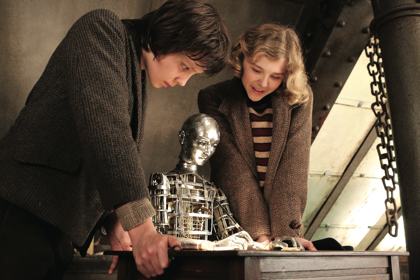
Hugo
What has influenced many who hated, or more often simply avoided, Avatar was the near-simultaneous arrival on UK screens earlier this year of two 3D documentaries: Werner Herzog’s Cave of Forgotten Dreams and Wim Wenders’s Pina. In both cases there is an interesting thematic link between the format and the film’s subject. Herzog takes us on a Jules Verne-like exploration of a lost world of prehistoric image-making, with 3D enabling us to ‘be there’; and Wenders uses the spatial illusionism of stereoscopy more fluently than Klaus Obermaier was able to in his 2007 experiment in 3D dance The Rite of Spring, recently seen in Birmingham and London. Few could doubt that 3D enhances Pina Bausch’s witty choreography. One future for 3D, now that the apparatus is widely available, must be for such innovative special attractions, and of course for a wide range of documentary subjects, especially in natural history.
But has it a future in dramatic film, other than for spectacle? One of the most encouraging recent pronouncements was Bernardo Bertolucci’s, on the occasion of his honorary Palme d’Or in Cannes this year. Having seen and “loved” Avatar, Bertolucci wondered why 3D should only be considered good for fantasy and science fiction. Imagine, he speculated, if Fellini’s 8½ or Bergman’s Persona had been stereoscopic. Imagine indeed! But if all goes well we’ll have his first venture, a chamber piece entitled Io e te (Me and You), to reveal how 3D can create intimate spaces. And before that, there’s the richly varied 3D menu in prospect this autumn of Scorsese’s Hugo, Spielberg’s The Adventures of Tintin and, with luck, Coppola’s partially 3D Twixt.
I mentioned to a Korean film academic that I was writing about 3D, and asked what he thought of it. Back came the response: “It’s a capitalist plot, isn’t it, to earn more at the box office and sell everyone new TVs?” He’s right, of course, though the same could be said for much of ‘normal’ cinema. 3D suits the audiovisual industry perfectly, especially when the software and hardware branches are linked. No wonder that Howard Stringer has committed Sony to 3D, since it has the potential to unify the company’s many interests in one mighty chain of vertical integration.
But whether or not that happens, I want to hold on to Lumière’s and Eisenstein’s and now Scorsese’s vision of what it could be. Hugo goes back to the beginnings of movie magic, with the discovery of silent-film pioneer Georges Méliès as an embittered old toy seller in the Gare Montparnasse. For Scorsese, it’s been an opportunity to pay tribute to the source of film’s intrinsic illusionism, with the novelty of 3D helping to transport modern audiences back to the sense of wonder once inspired by Méliès’s films. Will the cinema of tomorrow be stereoscopic – and holographic, and interactive? Why on earth not?
‘The Adventures of Tintin’ is now on general release in the UK. ‘Hugo’ is released on 2 December
The Adventures of Tintin The Secret of the Unicorn reviewed by David Jays (October 2011)
They live!: James Bell on the ‘Treasures from the Archive’ screenings at this year’s London Film Festival (October 2011)
Out of the darkness: Werner Herzog talks to Samuel Wigley about Cave of Forgotten Dreams (April 2011)
Alice in Wonderland reviewed by Lisa Mullen (April 2010)
A brief history of cinematography: Barry Salt on a century of technical and artistic developments in cinema lighting (April 2009)
Time after time: Charles Musser on editing pioneer Edwin S. Porter (March 1999)